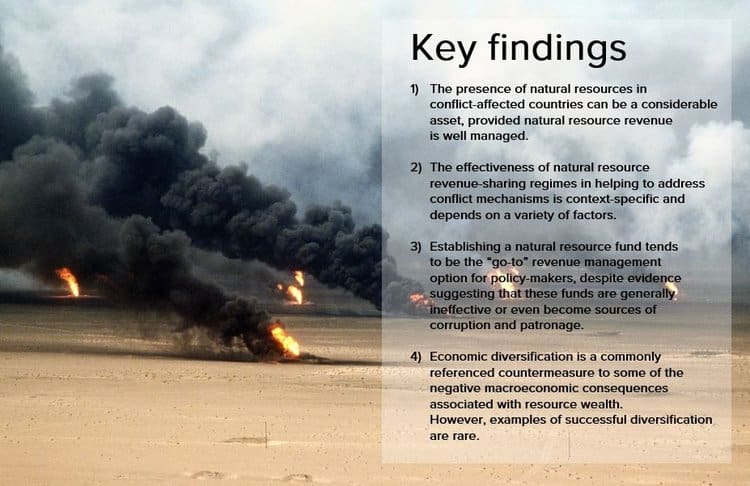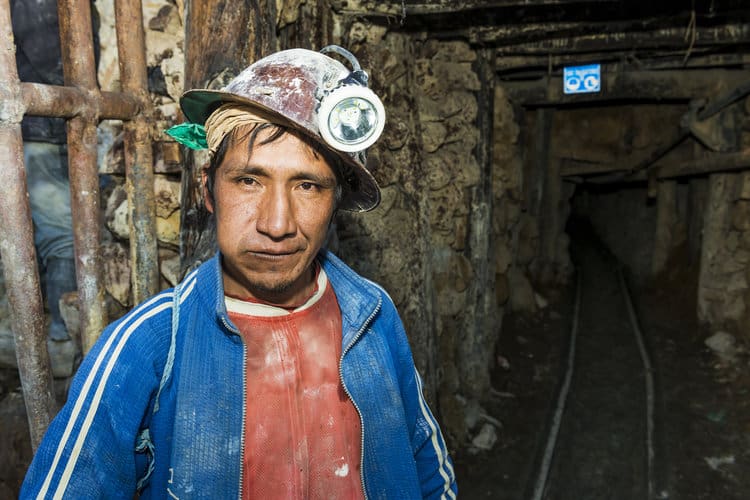This is the second in a series of four Deetken “Reflections” exploring the intersections between macroeconomic policy and fragility in countries affected by violent conflict. The first post in this “Reflections” series provided an overview of the key messages emerging from a review of over 100 sources and 10 expert interviews. In this post, we summarize what the evidence is telling us about how macroeconomic policies related to the management of natural resource revenues impact fragility in conflict-affected countries. We conclude with a number of evidence gaps that could form part of a future research agenda. This series builds on work that Deetken undertook on behalf of The World Bank and the United Nations.

Natural resource revenue is enormously important for many fragile and conflict-affected countries, in some cases representing over 90% of the value of exports. A significant body of literature considers the links between the development of natural resources and violent conflict. At the same time, a great deal of work focuses on how natural resource revenues can mitigate or prevent violence, support stability and help build conditions conducive to sustainable peace. This begs the question: under what conditions can natural resource revenues have peace-related benefits?
There are a number of different macroeconomic tools and approaches that can be used to manage natural resource revenue. In our review, we considered three of these:
1) Revenue-sharing regimes – These regimes focus on allocating or distributing the revenues from natural resources to subnational entities. An estimated 35 countries have a revenue-sharing regime, transferring $100 billion to subnational entities and certain groups.
2) Natural resource funds – These are extra-budgetary funds that provide a mechanism for putting aside or investing natural resource revenues in foreign or other assets. This converts natural assets into financial ones that can generate a sustainable income stream beyond the depletion of a natural resource. As of July 2014, they had been used in more than 40 countries and held approximately $4 trillion in assets.
3) Economic diversification – This refers to efforts to increase and diversify a country’s economic outputs to reduce dependency on natural resources revenues.
Here are four main findings emerging from our review of the evidence and our discussion with experts around the impact of natural resource revenue management on fragility.
Finding 1: The presence of natural resources in conflict-affected countries can be a considerable asset, provided natural resource revenue is well managed.
There is a considerable amount of research exploring the relationship between conflict and natural resources. The literature that focuses on identifying a link between natural resources and conflict tends to suggest that these relationships play out through six main mechanisms. Natural resources can:
i) provide a motive for conflict for both domestic and external actors;
ii) motivate or legitimize secessionist movements;
iii) provide financing to instigate and sustain violence;
iv) weaken state-society relations by compromising the taxation regime;
v) lead to a decline in the manufacturing sector (“Dutch disease”((Dutch disease occurs when a natural resource discovery is not matched with adequate absorption capacity, resulting in inflation or exchange rate appreciation. This can increase the costs of exported goods, harming exporters. It can also channel skilled workers and other resources away from other sectors, potentially weakening these sectors and creating a dependence on natural resources.)) ); and
vi) lead to volatility in commodity prices, potentially causing political and social instability.
Provisions over revenue-sharing can be instrumental in persuading warring parties to negotiate and implement a peace agreement. Furthermore, the revenue generated from natural resources can lead to growth and help fund initiatives aimed at building and sustaining peace (e.g. alleviating poverty, creating jobs, rebuilding infrastructure, revitalizing the economy, etc.). However, the peace-related benefits of natural resource revenues can only be achieved if these revenues are well-managed.
There is no single combination of policies or tools related to resource management that will work in every case. However, there is a general consensus around a number of guiding principles. These include the need for: 1) commitments to anti-corruption and the establishment of mechanisms to combat corruption around revenue management; 2) commitments to transparency and the establishment of mechanisms to ensure transparency of revenue management; 3) commitments and capacities to deliver on good governance principles to guide revenue management; and 4) political will on the part of all key stakeholders to deliver on commitments and to adhere to agreements around revenue management.
Finding 2: The effectiveness of natural resource revenue-sharing regimes in helping to address conflict mechanisms is context-specific and depends on a variety of factors.
Revenue-sharing regimes can play an important role in addressing some of the potential mechanisms for conflict by: 1) addressing local claims over resource ownership or demands for benefits, sometimes as a means of quelling secessionist inclinations; 2) compensating for the environmental, social or other costs associated with extraction; and 3) mitigating or preventing resource-related conflict by addressing demands for benefits or compensation that, if unmet, might manifest themselves violently.
However, these regimes can also trigger or exacerbate conflict. This may be particularly true in conflict-affected contexts where revenue-sharing agreements negotiated as part of a peace deal may not withstand the test of reality and may compel belligerents to resume fighting or where revenue-sharing is perceived to reward violence. In addition, if distributed along sectarian lines, resource revenues may exacerbate tensions between groups.
The effectiveness of revenue-sharing regimes in addressing conflict mechanisms tends to be context-specific and depends on a variety of factors, including the causes of conflict; the type of resource and its role in the conflict; the strength of domestic institutions and the regulatory/legal environment in which they operate; the internal and external power relations, interests and incentives at play in a particular context; the degree of political commitment, including to anti-corruption and transparency; and regional dynamics and international markets, among other factors.
Finding 3: Establishing a natural resource fund tends to be the “go-to” revenue management option for policy-makers, despite evidence suggesting that these funds are generally ineffective or even become sources of corruption and patronage.
In theory, natural resource funds(( These are extra-budgetary funds that can help address some of the macroeconomic challenges associated with natural resource wealth, including price volatility (one of the conflict mechanisms identified above), resource depletion or wealth inequality. These funds essentially provide a mechanism for putting aside or investing natural resource revenues in foreign or other assets, thereby converting natural assets into financial assets that can generate a sustainable income stream beyond the depletion of the physical asset. As of July 2014, they have been used in more than 40 countries and held approximately $4 trillion in assets.)) can help address some of the macroeconomic challenges and potential conflict mechanisms associated with natural resource wealth, including price volatility, resource depletion, and wealth inequality. However, the establishment of these funds needs to be carefully considered, particularly in conflict-affected contexts. A large comparative cross-country study on natural resource funds concluded that most of these funds are either ineffective or have become sources of corruption and patronage. Yet, establishing a natural resource fund tends to be the “go-to” revenue management option for both national and international policy-makers.
Finding 4: Economic diversification((According to the United Nations Framework Convention on Climate Change, “[e]conomic diversification is generally taken as the process in which a growing range of economic outputs is produced. It can also refer to the diversification of markets for exports or the diversification of income sources away from domestic economic activities (i.e. income from overseas investment).” Click here for more information.)) is a commonly referenced countermeasure to some of the negative macroeconomic consequences associated with resource wealth. However, examples of successful diversification are rare.
The evidence suggests that economic diversification success stories are not particularly common in part because diversification is difficult to achieve, the process is susceptible to corruption, and control over natural resource revenue can be highly politicized. The literature reveals three main policy responses to the need for economic diversification in resource-rich, conflict-affected contexts. These include: i) a push for greater transparency of how resource revenue is spent to ensure that agreed upon portions of this revenue are invested in developing other industries; ii) establishing a natural resource fund that would allow natural resource revenue to be used to build up other sectors of the economy; and 3) promoting “local content” (i.e. promoting local employment, technical training and procurement for the resource sector with the objective of creating a spill-over effect into other industries).

Evidence gaps and future research
One of the key messages that we explored in Part 1 of this Reflections series on macroeconomic policies in conflict-affected contexts related to the need for more context-specific evidence exploring how macroeconomic policy and fragility intersect in conflict-affected settings. Our review of the evidence around natural resource revenue management and fragility, together with our conversations with experts, revealed the following areas that might benefit from further research or evidence gathering.
1) There is limited research on how and why existing revenue-sharing regimes were negotiated or developed in the first place (e.g. what were the motivations/incentives for introducing a revenue management regime in the first place? Conflict prevention? Peacebuilding? Economic growth? A critical bargaining chip in the peace process?).
2) There is a paucity of systematic or comparative analysis exploring whether the objectives of these regimes (i.e. the reasons why they were first established) have been achieved.
3) There is limited research related to exploring if different revenue-sharing regimes are more (or less) effective in managing different types of resources.
4) There is a dearth of comparative, policy-relevant analysis around natural resource funds and how they have (or have not) been effective mechanisms for managing natural resource revenues in conflict-affected contexts. Specifically, there is a lack of systematic evidence exploring if/how natural resource funds have helped address conflict mechanisms (e.g. smooth out the effects of price volatility, save for the post-resource depletion period, address wealth inequality through development projects, mitigate Dutch disease or be channelled into economic diversification investments) or if they are more likely to facilitate corruption and patronage.
There is a considerable body of literature focused on economic reconstruction, including in conflict-affected contexts. However, there appears to be a paucity of research considering economic diversification through a natural resources lens; that is, there is a lack of research looking at how resource-rich, conflict-affected countries or regions have (successfully or otherwise) diversified their economies and how natural resource revenues themselves have been used (successfully or otherwise) to support economic diversification.
Click to read the overview of the series “Macroeconomic Policies in Conflict-Affected Contexts”,the third in the series, “Tax Policy and Fragility in Conflict-Affected Contexts” and the final in the series, “Monetary and Exchange Rate Policy in Conflict-Affected Contexts”.
For more information, contact: info@deetken.com



